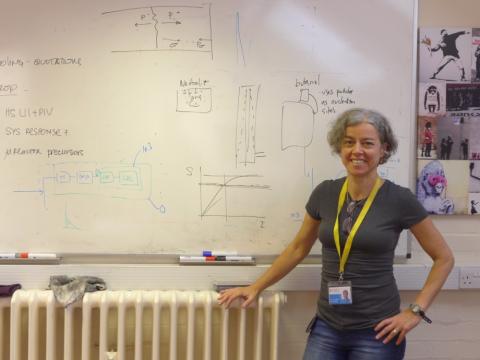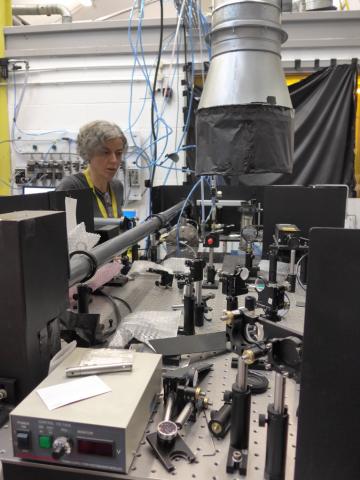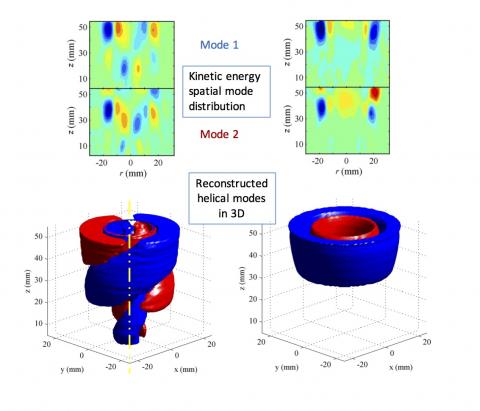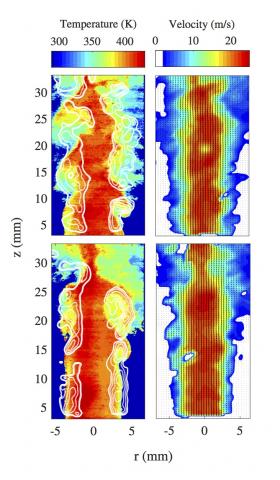Simone is a Professor in the Energy, Fluids and Turbomachinery Division
(interviewed by Girish Nivarti)
How did you get into Engineering?
I grew up without any engineers in the family, or even anybody who had gone to college who would inspire me as a role model. I liked maths and I liked physics but I knew I didn’t want to be a teacher (rather ironic in retrospect)— so engineering sounded like a good compromise. It combines the maths and physics into interesting problems and yet the original goal was towards industry rather than teaching at a university.

[Moreover,] as an undergraduate, there was a huge energy crisis and because I grew up in a big city in a developing nation, I was motivated by a social drive towards solving new problems of scarcity. This idea of doing more with less, dictated by the laws of thermodynamics, motivated me through my engineering degree. Most of all, engineering had answers, which did not depend on whether you liked them or not, just puzzles that were so satisfying to solve!
What is your research focused on? What drives you to do this research?
My group focuses on measurements in reacting flows, from flames to aerosols to materials synthesis. I started my graduate career doing analytical work, but realized I did not understand why good ideas did not become a reality, so I gravitated towards experiments to find out. My interest in optical diagnostics developed while at MIT, where I worked as faculty for 9 years, looking to peek into flames and sprays in engines. Looking at problems through most of my career, I have found that the more satisfying work is often driven by what an interesting phenomenon, rather than research driven by external opportunities. Much of what I have worked on has been on understanding the phenomenology and physics of particular flows, rather than further improvements in modelling.
What drives you to pursue engineering?
Cambridge is a great organisation and one is easily humbled by the talent around here! What I do is driven not only by trying to understand something for myself, but largely by society’s needs. The Cambridge mission statement states that it is to contribute to society. To make a difference is of course what motivates me to look at these research problems everyday – although sometimes it is hard to judge the impact of our work upfront!
What is an achievement you are proud of?
I take everything with a grain of salt, so I couldn’t really point to something that I am extremely proud of. It makes me happy to propagate a clear and rigorous way of thinking both at a personal level and for others. I am happy when another researcher uses our data or idea in their own pursuits. Getting the occasional positive feedback from students and researchers who might say “now I am getting the picture!” is always satisfying to hear. At the same time, I have often learned so much from my students and that is equally satisfying.
What is the most difficult situation you’ve faced?
Oh, there are too many of them! The technical difficulties can be disheartening, when an apparently good idea fails. But the hardest challenges are how to work together with many students and researchers in an effective way, and not necessarily dwelling on bets that did not work. The alternative to overcoming the challenges, however, is to not move on. My advice is to be self-critical but not to feel too guilty about failures. What is important is to learn from these failures: to ask “why did it not work?”. This applies both to technical issues and personal relationship failures. It is completely alright to fail — research sometimes means to jump off into the deep end of the pool and struggle — one must use such failures to learn and change.
Do you have any role models?
Yes! At the top of the list, my colleague Rob Barlow from Sandia Labs has a great ethical vision of research work and of the world, and he lives by it. Forman Williams, Irvin Glassman, Thierry Poinsot and many others showed me the true joy of research, and that is very inspiring. They are always digging, looking for new things to learn. I tend to gravitate to people who place the love for science higher than the trajectory of their careers — the kind of people who will call you aside and say: “let me show you something really neat”.

What makes you go on?
Looking ahead, I am much more interested solving problems that are important for mankind rather than solely things that advance one’s career. Focusing on quality over quantity and something that brings the greater good rather than immediate reward. I also like being surrounded by problems that push me out of my depth; it makes me go back to basics and think critically. However, I remember Millie Dresselhaus telling me once that “you should always move adiabatically”, that is, only move into new problems if you can do so without spending much time learning the basics. Moving areas keeps you interested, but comes with a price, as it is difficult to become an expert in all those new problems.
How do you manage family life?
The big choice often becomes between doing well in your career and investing in family life, and the priority becomes obvious — not work! Having children is of course the best thing in a life and it completely changes you as a person. Managing family life with career is difficult, but I have been lucky because our university offers good support: the nursery is just down the road, and academia is a flexible job and it allows you to tailor your routine according to your needs. Travelling for work is challenging, as it can be emotionally wrenching to be away from small children. In an ideal future world, it would be nice to have a balance not only of women being encouraged to pursue science but also men being respected while being allowed to take their families seriously and take time to raise children.
Any further advice for prospective women students?
A difficult problem in the UK is that engineering is not necessarily regarded as the prestigious profession it is elsewhere: engineers are seen as boiler fixers rather than inventors [not that there is anything wrong with very useful boiler fixers!]! Even Dyson calls himself an ‘inventor’ rather than an ‘engineer’! Engineering is a fun, creative profession in puzzle mastering. Engineering combines all the fun of physics plus the possibility of actually being immediately useful — a hard pair to beat. Engineering research is also very much a human business — one has to learn to work with a variety of other people, as one needs many individuals with different skills and perspectives. Our ideas, goals and pursuits are very much shaped by who we work with, so things could be quite different if there were a 50-50 gender balance in the profession. The possibilities of how the field could change if that were the case are quite exciting. Medicine changed dramatically since women became half of that workforce – just imagine if engineering were to follow!
Further Links
http://www-g.eng.cam.ac.uk/reactingflows/.

[More on Simone’s research]
Could you tell us more about your current projects?
In one of the projects that came from a collaboration with Oxford, we are trying to come up with an accurate way to measure temperature. We do this by measuring the local speed of sound directly using molecules which absorbs light and release a pressure pulse. Sadly, many of the nice absorbing molecules do not survive combustion! So the focus is to find appropriate absorbers – at the moment it looks like NO may work, which would be nice, as we would be able to get both emissions and temperatures at athe same time.
A second theme is understanding how temperature non-uniformities in combustors generates instabilities, as this is of great interest to the gas turbine industry. We put together a very simple rig where we generate these entropy spots electrically and observe them march through a nozzle; the intensity of the sound generated is not matched by the current theory, so we are looking at what is the reason. We would like to apply our temperature measurement technique above to measure these non- uniformities once the whole rig works. We are also developing an imaging technique capable of measuring measure temperature and velocity fluctuations simultaneously. So, in principle, we could do both — with the help of a few extra cameras!

We also working on a few other collaborative projects together with Adam Boies (Lecturer in Engineering). We are developing a particle sensor for measuring very fine (sub 100-nm) particulate matter in the atmosphere, supported by a local sensor company. Using UV light we charge the particles, and measure the resulting charge. In our method, we found out that we can potentially measure both the size and concentration of particles. This has also led to some interesting CFD simulations on the transport and generation of charged particles – oddly there has not been much work in this area yet! Again the physics is new and exciting puzzles are all open to be solved!
Another project with collaborators in Materials Science and other colleagues in engineering has been to understand how to increase the production of carbon nanotube fibres in a furnace. The production of carbon nanotubes in pyrolytic environments has been around for 20 years or so, the materials science department here has managed to pull these nanotubes into fibres which are strong and have very attractive strength and conductivity properties. We are looking at both how to use these fibres and how to increase the yield and decrease their cost. We are again shining lasers into these reacting flows to understand the intermediate steps involved using spectroscopy.

